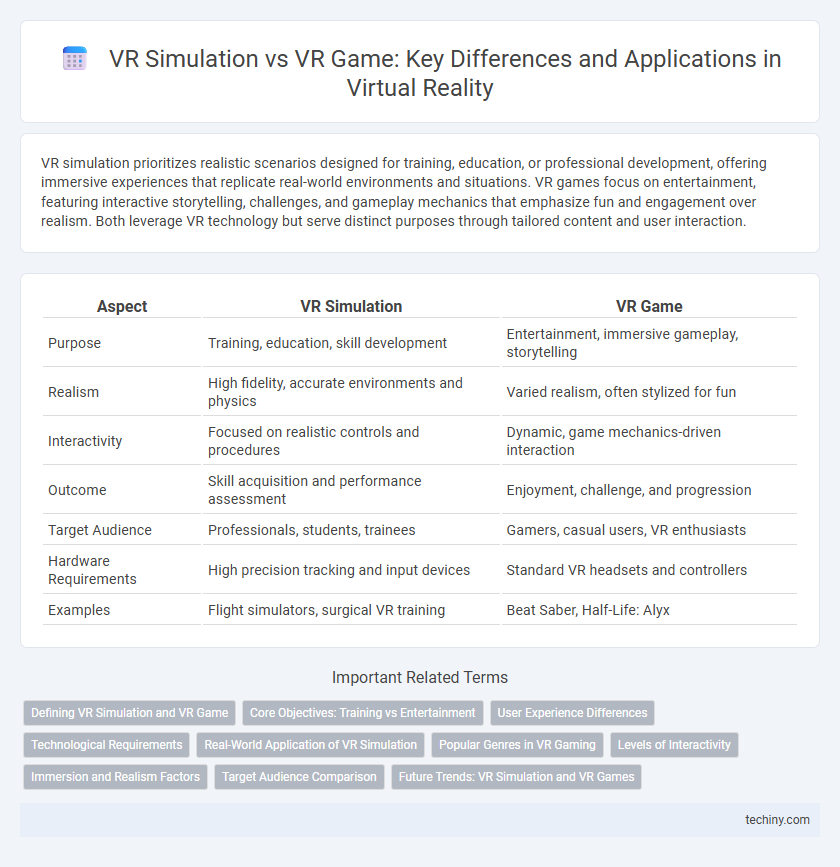VR simulation prioritizes realistic scenarios designed for training, education, or professional development, offering immersive experiences that replicate real-world environments and situations. VR games focus on entertainment, featuring interactive storytelling, challenges, and gameplay mechanics that emphasize fun and engagement over realism. Both leverage VR technology but serve distinct purposes through tailored content and user interaction.
Table of Comparison
| Aspect | VR Simulation | VR Game |
|---|---|---|
| Purpose | Training, education, skill development | Entertainment, immersive gameplay, storytelling |
| Realism | High fidelity, accurate environments and physics | Varied realism, often stylized for fun |
| Interactivity | Focused on realistic controls and procedures | Dynamic, game mechanics-driven interaction |
| Outcome | Skill acquisition and performance assessment | Enjoyment, challenge, and progression |
| Target Audience | Professionals, students, trainees | Gamers, casual users, VR enthusiasts |
| Hardware Requirements | High precision tracking and input devices | Standard VR headsets and controllers |
| Examples | Flight simulators, surgical VR training | Beat Saber, Half-Life: Alyx |
Defining VR Simulation and VR Game
VR simulation involves immersive, interactive environments designed to replicate real-world scenarios for training, education, or analysis, emphasizing realism and accuracy. VR games prioritize entertainment through engaging narratives, challenges, and gameplay mechanics within virtual worlds. Both utilize virtual reality technology but serve distinct purposes in user experience and application.
Core Objectives: Training vs Entertainment
VR simulation prioritizes realistic scenarios and skill development, aiming to enhance professional training outcomes in fields such as aviation, medicine, and military operations. VR games focus on immersive entertainment, engaging users through interactive storylines, challenges, and sensory experiences designed for leisure. The core objective differentiates by targeting functional proficiency in simulations versus enjoyment and escapism in gaming.
User Experience Differences
VR simulation prioritizes realistic environments and precise interaction models to enhance training, education, or skill development, often emphasizing accuracy and immersion over entertainment. VR games focus on engaging gameplay, dynamic narratives, and user-driven challenges designed to maximize fun, emotional impact, and replayability through immersive storytelling and interactive mechanics. User experience in VR simulation tends to be task-oriented with controlled scenarios, while VR games offer exploratory, spontaneous interactions that stimulate excitement and creativity.
Technological Requirements
VR simulations demand higher precision in hardware and software integration to ensure realistic interactions and accurate data capture, often utilizing advanced sensors and haptic feedback devices. VR games prioritize immersive graphics and responsive controls, requiring powerful GPUs and low-latency tracking systems to maintain smooth gameplay and user engagement. Both rely on optimized VR headsets and spatial audio technologies, but simulations emphasize fidelity and real-world accuracy, whereas games focus on entertainment and interactive responsiveness.
Real-World Application of VR Simulation
VR simulation excels in real-world applications by providing immersive training environments for industries like healthcare, aviation, and military, enabling risk-free practice of complex procedures. Unlike VR games designed for entertainment, VR simulations prioritize accuracy and realism to enhance skill development and decision-making in high-stakes scenarios. This practical application significantly improves learning outcomes and operational efficiency across various professional fields.
Popular Genres in VR Gaming
Popular genres in VR gaming include action, adventure, horror, and simulation, each offering unique immersive experiences that distinguish them from traditional VR simulations designed primarily for training or education. VR games emphasize interactive storytelling, real-time decision-making, and dynamic environments, while VR simulations focus on replicating real-world scenarios for skill development or practice. Action and horror VR games leverage motion tracking and haptic feedback to intensify player engagement, whereas simulations are often used in industries like healthcare, aviation, and military for realistic scenario-based learning.
Levels of Interactivity
VR simulation offers highly realistic environments designed for training, education, and skill development with precise control over variables and outcomes. VR games emphasize immersive entertainment, featuring dynamic, responsive interactions that adapt to player choices and actions. The level of interactivity in VR simulations prioritizes accuracy and replicability, while VR games focus on engagement and adaptive gameplay experiences.
Immersion and Realism Factors
VR simulations prioritize high immersion and realism by replicating real-world physics, environments, and interactions to train users effectively in professional or educational contexts. VR games emphasize engaging gameplay and entertainment while incorporating immersive elements, often balancing realistic graphics with creative freedom and user experience. The key difference lies in VR simulations aiming for authenticity and practical application, whereas VR games focus on fun and interactive storytelling within virtual environments.
Target Audience Comparison
VR simulations primarily target professionals in industries such as healthcare, aviation, and engineering who require immersive training environments. VR games appeal to a broader audience including casual gamers and enthusiasts seeking entertainment and interactive storytelling. The distinction lies in the purpose and user engagement, where simulations emphasize realism and skill development, while games focus on enjoyment and challenge.
Future Trends: VR Simulation and VR Games
VR simulation and VR games are poised to evolve with advancements in AI-driven environments and haptic feedback technology, enhancing realism and user immersion. The integration of cloud computing and 5G networks will enable seamless, large-scale multiplayer experiences and real-time data processing in VR scenarios. Future trends indicate a convergence where VR simulations become increasingly gamified, merging training effectiveness with engaging gameplay mechanics for diverse industries.
VR Simulation vs VR Game Infographic

 techiny.com
techiny.com